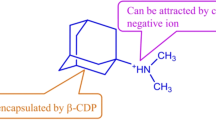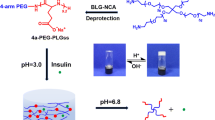Abstract
To accelerate the response rate of smart hydrogels to the environmental conditions, a novel pH-sensitive p(PEGMA-g-MAA) hydrogel microsphere with the controlled shapes and sizes were developed. Such monodispersed microspheres were synthesized via free radical polymerization under the protection of a multilayer stability system. The pH-responsibility of hydrogel microspheres was tested with the hydrogel bulk as a control. In vitro release studies were conducted in the simulated gastric fluid and intestinal juice with bovine serum albumin (BSA) as a model drug. The large specific surface areas endowed hydrogel microspheres a faster pH-responsibility than that of hydrogel bulk. In vitro release profiles showed that over 90 % BSA were released from hydrogel microspheres under the alkaline conditions (pH 7.4), which was faster than those from hydrogel bulks. In sum, the rapid pH-responsibility and ideal drug release profile could shorten the lag time to steady plasma-drug concentration, which was beneficial to increasing the therapeutic effect of the drugs.












Similar content being viewed by others
References
Amin MCIM, Ahmad N, Halib N, Ahmad I (2012) Synthesis and characterization of thermo- and pH-responsive bacterial cellulose/acrylic acid hydrogels for drug delivery. Carbohyd Polym 88:465–473
Casolaro M, Casolaro I, Lamponi S (2012) Stimuli-responsive hydrogels for controlled pilocarpine ocular delivery. Eur J Pharm Biopharm 80:553–561
Chen Y, Liu Y, Tang H, Tan H (2010) Study of carboxymethyl chitosan based polyampholyte superabsorbent polymer I Optimization of synthesis conditions and pH sensitive property study of carboxymethyl chitosan-g-poly(acrylic acid-co-dimethyldiallylammonium chloride) superabsorbent polymer. Carbohyd Polym 81:365–371
Eid M (2008) In vitro release studies of vitamin B12 from poly N-vinyl pyrrolidone/starch ydrogels grafted with acrylic acid synthesized by gamma radiation. Nucl Instrum Meth B 266:5020–5026
Gao XY, He CL, Xiao CS, Zhuang XL, Chen XS (2013) Biodegradable pH-responsive polyacrylic acid derivative hydrogels with tunable swelling behavior for oral delivery of insulin. Polymer 54:1786–1793
Jin X, Hsieh YL (2005) pH-responsive swelling behavior of poly(vinyl alcohol)/poly(acrylic acid) bi-component fibrous hydrogel membranes. Polymer 46:5149–5160
Johnson BD, Beebe DJ, Crone WC (2004) Effects of swelling on the mechanical properties of a pH-sensitive hydrogel for use in microfluidic devices. Mat Sci Eng C 24:575–581
Kavimandana NJ, Losib E, Peppas NA (2006) Novel delivery system based on complexation hydrogels as delivery vehicles for insulin-transferrin conjugates. Biomaterials 27:3846–3854
Yun J, Kim HI, J (2009) Preparation of poly(vinyl alcohol)/poly(acrylic acid) microcapsules and microspheres and their pH-responsive release behavior. J Ind Eng Chem 15:902–906
Li X, Xu SM, Wang JD, Chen XZ, Feng S (2009) Structure and characterization of amphoteric semi-IPN hydrogel based on cationic starch. Carbohyd Polym 75:688–693
Liang Y, Chen T, Cui Y, Tian R, Qi T, Shang Q (2014) Synthesis and performance of pH-sensitive hydrogel microspheres and in vitro evaluation as potential drug carriers. Adv Materials Res 936:751–756
Lugo MT, Garcia M, Record R, Peppas NA (2002) Physicochemical behavior and cytotoxic effects of p(methacrylic acid-g-ethylene glycol) nanoparticles for oral delivery of proteins. J Control Release 280:197–205
Mariko M, Takahiro G, Koji N, Anthony ML, Kozo T, Nicholas AP (2006) Novel oral insulin delivery systems based on complexation polymer hydrogels: single and multiple administration studies in type 1 and 2 diabetic rats. J Control Release 110:587–594
Morishita M, Lowman AM, Takayama K, Nagai T, Peppas NA (2002) Elucidation of the mechanism of incorporation of insulin in controlled release systems based on complexation polymers. J Control Release 81:25–32
Naresh KB, Matthew S, Justin RB (2011) Chemistry between crosslinks affects the properties of peptide hydrogels. Mat Sci Eng C 31:1042–1049
Phithupha C, Anuvat S, Sumonman N, Datchanee C, Kwanchanok VP (2009) Controlled transdermal iontophoresis of sulfosalicylic acid from polypyrrole/poly (acrylic acid) hydrogel. Int J Pharm 381:25–33
Pourjavadi A, Barzegar S, Zeidabadi F (2007) Synthesis and properties of biodegradable hydrogels of κ-carrageenan grafted acrylic acid-co-2-acrylamido-2- methylpropanesulfonic acid as candidates for drug delivery systems. React Funct Polym 67:644–654
Shang Q, Zhang YH, Chen T, Liang YY, Shi YL (2013) Preliminary studies on pH-sensitive hydrogels and in vitro release profiles of two model drugs. J Biomat Sci-Polyme E 112:1459–1471
Shi YL, Zheng T, Shang Q (2012) Preparation of acrylic/acrylate copolymeric surfactants by emulsion polymerization used in pesticide oil-in-water emulsions. J Appl Polym Sci 123:3117–3127
Spagnol C, Rodrigues FHA, Pereira AGB, Fajardo AR, Rubira AF, Muniz EC (2012) Superabsorbent hydrogel composite made of cellulose nanofibrils and chitosan- graft-poly(acrylic acid). Carbohyd Polym 87:2038–2045
Wang K, Fu SZ, Gu YC, Xu X, Dong PW, Guo G, Zhao X, Wei YQ, Qian ZY (2009a) Synthesis and characterization of biodegradable pH-sensitive hydrogels based on poly(ε-caprolactone), methacrylic acid, and poly(ethylene glycol). Polym Degrad Stabil 94:730–737
Wang Q, Zhang JP, Wang AQ (2009b) Preparation and characterization of a novel pH-sensitive chitosan-g-poly (acrylic acid)/attapulgite/sodium alginate composite hydrogel bead for controlled release of diclofenac sodium. Carbohyd Polym 78:731–737
Wood KM, Stone GM, Peppas NA (2010) The effect of complexation hydrogels on insulin transport in intestinal epithelial cell models. Acta Biomater 6:48–56
Zhang YH, Shang Q, Zheng T, Liang YY, Chen T (2012) Preparation of pH sensitive hydrogels for oral delivery of proteins. icBEB2012 Conference, pp 457–560
Acknowledgments
The authors would like to thank the financial support by the Natural Science Foundation of Hebei province, China (No. C2011208111).
Conflict of interest
The authors declare no conflict of interest.
Author information
Authors and Affiliations
Corresponding author
Rights and permissions
About this article
Cite this article
Tian, R., Liang, Y., Zhang, X. et al. Synthesis and performance of pH-sensitive hydrogel microspheres and in vitro evaluation as potential drug carriers. Microsyst Technol 21, 2287–2296 (2015). https://doi.org/10.1007/s00542-014-2355-9
Received:
Accepted:
Published:
Issue Date:
DOI: https://doi.org/10.1007/s00542-014-2355-9




